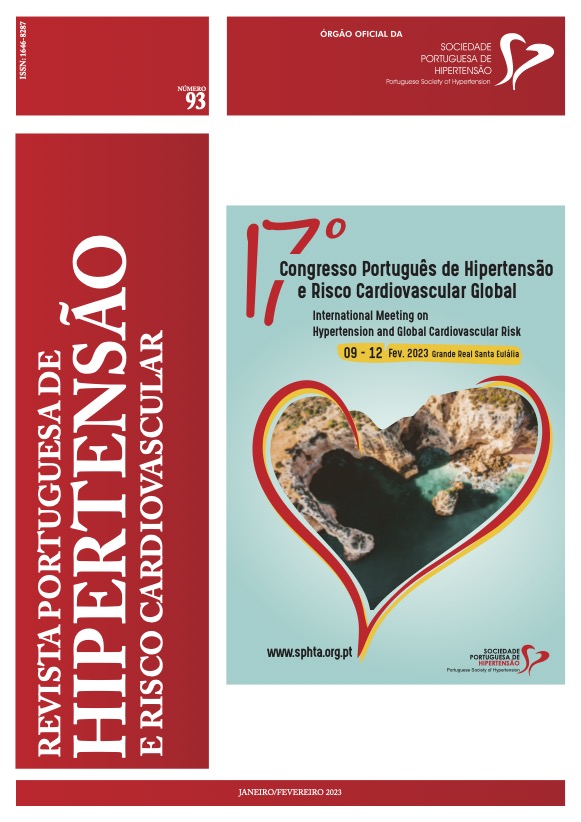DIRECT ORAL ANTICOAGULANTS ADJUSTMENT TO RENAL FUNCTION IN ATRIAL FIBRILLATION AND ATRIAL FLUTTER
DOI:
https://doi.org/10.58043/rphrc.55Keywords:
Anticoagulants, glomerular filtration Rate, atrial fibrillation, atrial flutteAbstract
Introduction: Atrial fibrillation and flutter are prevalent conditions. Direct oral anticoagulants require dose adjustment to glomerular filtration rate. The objective of this study was to assess the quality of prescription of direct oral anticoagulants in adults with these pathologies.
Methods: We conducted an observational study in 5 Portuguese health care centers. We included adults with atrial fibrillation or flutter, a glomerular filtration rate under 50 mL/min, treated with direct oral anticoagulants and with updated weight and creatinine between june 2020 and may 2021. Glomerular filtration rate was calculated using Cockcroft-Gault formula and direct oral anticoagulants’ prescription adequacy was confirmed according to the summary of product characteristics. A descriptive analysis of the population was made. A correlation between prescription adequacy and patient characteristics, as well as the prescribed direct oral anticoagulant was assessed.
Results: From 95 adults, 43 (45,3%) were male, with an average age of 83 years. 46 (48,4%) presented with inadequate anticoagulant prescription, from whom, 43 (45,3%) had an incorrect dosage and 3 (3,2%) had a formal contraindication to the treatment. We found no association between prescription adequacy, sociodemographic characteristics or the prescribed direct oral anticoagulant.
Discussion: This study suggests that there is an important prevalence of inappropriate prescription of direct oral anticoagulant in patients with reduced glomerular filtration rate in primary health care, compromising the efficacy and safety of this medication. The glomerular filtration rate vigilance is necessary for a correct prescription of direct oral anticoagulants in patients with atrial fibrillation and flutter.
Downloads
References
Monteiro P. The SAFIRA study: A reflection on the prevalence and treatment patterns of atrial fibrillation and cardiovascular risk factors in 7500 elderly subjects. Revista Portuguesa de Cardiologia. 2018;37:307-313.
Bonhorst D. Um novo olhar sobre a prevalência da fibrilhação auricular em Portugal - O Estudo Safira. Revista Portuguesa de Cardiologia. 2018;37:315-317.
Ghali WA,Wasil BI,Brant R,Exner D v.,Cornuz J. Atrial flutter and the risk of thromboembolism: A systematic review and meta-analysis. American Journal of Medicine. 2005;118:101-107.
Hindricks G, Potpara T, Dagres N, Bax J, Boriani G, Dan G et al. 2020 ESC Guidelines for the diagnosis and management of atrial fibrillation developed in collaboration with the European Association for Cardio-Thoracic Surgery (EACTS). European Heart Journal. 2021;42:373-498.
Heidbuchel H, Verhamme P, Alings M, Antz M, Hacke W, Oldgren J et al. European Heart Rhythm Association Practical Guide on the use of new oral anticoagulants in patients with non-valvular atrial fibrillation. Europace. 2013;15:625-651.
Zhang ZX, van de Garde EMW, Söhne M, Harmsze AM, van den Broek MPH. Quality of clinical direct oral anticoagulant prescribing and identification of risk factors for inappropriate prescriptions. British Journal of Clinical Pharmacology. 2020;86:1567-1574.
Whitworth MM, Haase KK, Fike DS, Bharadwaj RM,Young RB,MacLaughlin EJ.Utilization and prescribing patterns of direct oral anticoagulants. International Journal of General Medicine. 2017;10:87-94.
Aursulesei V, Costache II. Anticoagulation in chronic kidney disease: from guidelines to clinical practice. Clinical Cardiology. 2019;42:774-782.
Ortiz MR, Muñiz J, Míguez PR, Roldán I, Marin F, Esteve-Pastor MA et al. Inappropriate doses of direct oral anticoagulants in real-world clinical practice: Prevalence and associated factors. A subanalysis of the FANTASIIA registry. Europace. 2018;20:1577-1583.
Chan KE, Giugliano RP, Patel MR, Abramson S, Jardine M, Zhao S et al. Nonvitamin K Anticoagulant Agents in Patients With Advanced Chronic Kidney Disease or on Dialysis With AF. Journal of the American College of Cardiology. 2016;67:2888-2899.
Kcükköylü S, Rump LC. DOAC use in patients with chronic kidney disease. Hamostaseologie. 2017;37:286-294.
Downloads
Published
How to Cite
Issue
Section
License
Copyright (c) 2023 Mariana Pereira, Nuno Caires, Maria Beatriz Morgado, Rita L. Silva, Catarina Capella

This work is licensed under a Creative Commons Attribution 4.0 International License.




